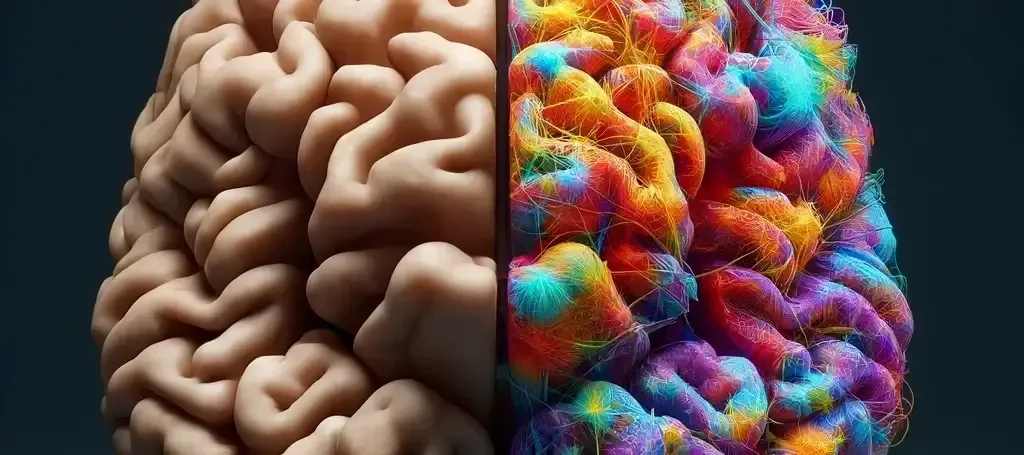Understanding Brain Development from Infancy to Toddlerhood
Brain development during infancy and toddlerhood is a fascinating and complex process involving various brain regions. Let’s delve into the intricate mechanisms driving this development.
Neural Growth and Pruning
At birth, a baby’s brain contains many largely unconnected neurons. However, during infancy, these neurons rapidly form synapses, the connections that allow communication between neurons. This process is influenced by both genetic factors and the child’s experiences. It’s important to note that during this period, the brain exhibits its highest level of neuroplasticity, meaning it can adapt and reorganize in response to experiences.
Pruning of Synapses
The brain undergoes pruning as the child grows and interacts with the environment. This involves eliminating seldom-used synapses, making the brain more efficient. Pruning continues into adolescence, shaping the neural circuitry to enhance meaningful connections while eliminating unnecessary ones.
Regions Involved The cerebral cortex, responsible for complex cognitive functions such as reasoning and decision-making, is particularly active during neural growth and pruning. Additionally, the limbic system, which plays a crucial role in emotional regulation, experiences significant changes during this period.
Myelination
Process of Myelination
Myelination is the development of a fatty sheath called myelin around the axons of neurons. This sheath increases the speed of electrical signals between neurons, enhancing the brain’s ability to process information efficiently.
Timing and Significance
Myelination begins prenatally and continues into young adulthood, with the most significant changes occurring during the first two years of life. This period of intense myelination lays the foundation for the brain’s communication network.
Regions Involved While myelination occurs throughout the brain, certain areas undergo particularly significant changes. For instance, the corpus callosum, which connects the brain’s two hemispheres, experiences enhanced communication due to myelination. Additionally, sensory processing and motor skills development regions undergo substantial myelination during this period.
Critical Periods
Critical periods are specific times in early development when the brain is particularly sensitive to external stimuli. During these periods, the brain is primed to develop specific abilities, such as language, vision, and emotional attachment.
Language Development
The critical period for language development begins in infancy and extends into early childhood. During this time, the left hemisphere of the brain, particularly areas like Broca’s area (responsible for speech production) and Wernicke’s area (responsible for language comprehension), undergo rapid development, laying the foundation for language acquisition.
Visual Development
The visual cortex, located in the occipital lobe at the back of the brain, is highly receptive to visual stimuli during the first few years of life. This critical period is crucial for establishing foundational visual abilities like depth perception and object recognition.
Sensory and Motor Development
Early Development During early development, the primary sensory areas responsible for processing information from the environment and the motor areas accountable for initiating movement develop rapidly. This allows infants to start interacting with and understanding the world around them.
Neurodevelopmental Variations in Autism from Infancy to Toddlerhood
Autism Spectrum Disorder (ASD) impacts brain development in unique ways that differ from typical developmental trajectories. This complex neurodevelopmental condition is characterized by challenges in social interaction and communication and restricted or repetitive patterns of behaviour or interests. Here’s an in-depth look at how brain development in children with autism may differ from infancy through toddlerhood.
Early Brain Development and Overgrowth One of the most significant findings in autism research is the early brain overgrowth that often occurs in children with ASD. Studies suggest that, unlike typical infants, many autistic infants may experience an accelerated brain growth rate during the first years of life. This rapid brain growth can result in an unusually large head circumference (macrocephaly) in some toddlers with autism.
Synaptic Development and Pruning In typical development, infants experience a surge in synapse formation followed by pruning, which refines brain function. In children with autism, however, both processes can be atypical. There is evidence suggesting excessive synapse formation and insufficient pruning in autistic brains. This could lead to an overload of neural connections that might not be effectively integrated. This lack of efficient pruning has been linked to difficulties in sensory processing, social interactions, and higher cognitive functions due to the noisy and less efficient neural networks.
Myelination Differences Myelination, the process by which brain cells are insulated with a myelin sheath, is crucial for efficient neural communication. In autism, the myelination process might be altered or delayed, affecting the speed and timing of nerve signals. This disruption can impact a range of functions, from basic sensory processing to more complex behaviours such as social communication and emotional regulation.
Development of Specific Brain Regions
- Frontal Cortex: Typically involved in complex cognitive behaviour and social interactions, the frontal cortex in children with autism may show atypical development. This brain area may not integrate information as effectively as in neurotypical development, which can manifest in challenges with executive functions like planning, attention, and impulse control.
- Temporal Regions: Involved in language and facial emotion recognition, the temporal areas in autistic children may develop differently, impacting their ability to process verbal cues and recognize emotional expressions.
- Amygdala: Early overgrowth in the amygdala has been observed in young children with autism. The amygdala plays a crucial role in processing emotions; its early overgrowth might relate to the intense anxiety and emotional responses seen in some children with ASD.
Critical Periods In autism, the critical periods when the brain is particularly receptive to certain input types might be altered. For example, the critical period for language development may be affected, contributing to the common delays in speech and language skills observed in many children with ASD. Similarly, altered critical periods for sensory processing might explain the sensory sensitivities common in autism.
Social and Emotional Development Due to the atypical development of social brain circuits, infants and toddlers with autism might show less attention to social stimuli, such as faces or voices. This can lead to difficulties in social interaction, such as reduced eye contact, limited use of gestures, and challenges in developing peer relationships.
Cognitive Development: While some children with autism typically develop cognitive skills, others might show delays or uneven development. For instance, a child might have difficulties with problem-solving or flexibility in thinking but excel in memory or detail-focused tasks.
In summary, the development of an autistic infant to toddler involves unique pathways that affect various aspects of neurology and behaviour. These developmental differences underline the importance of early intervention and tailored support to address the specific needs of each child with ASD, enhancing their ability to engage with the world around them.
Resources
Almli, C. R., Rivkin, M. J., & McKinstry, R. C. (2007). The NIH MRI study of Normal Brain Development (objective-2): Newborns, infants, toddlers, and preschoolers. NeuroImage, 35(1), 308–325. https://doi.org/10.1016/j.neuroimage.2006.08.058
Huang, H., Shu, N., Mishra, V., Jeon, T., Chalak, L., Wang, Z. J., Rollins, N., Gong, G., Cheng, H., Peng, Y., Dong, Q., & He, Y. (2013). Development of human brain structural networks through infancy and childhood. Cerebral Cortex, 25(5), 1389–1404. https://doi.org/10.1093/cercor/bht335
Scott, L. S., & Brito, N. H. (2022). Supporting Healthy Brain and behavioral development during infancy. Policy Insights from the Behavioral and Brain Sciences, 9(1), 129–136. https://doi.org/10.1177/23727322211068172
Nature,Nuture and Early Brain Development https://extension.missouri.edu/media/wysiwyg/Extensiondata/Pub/pdf/hesguide/humanrel/gh6115.pdf
DiPietro, J. A. (2000). Baby and the brain: Advances in child development. Annual Review of Public Health, 21(1), 455–471. https://doi.org/10.1146/annurev.publhealth.21.1.455
Bresnahan, M., Hornig, M., Schultz, A. F., Gunnes, N., Hirtz, D., Lie, K. K., … & Lipkin, W. I. (2015). Association of maternal report of infant and toddler gastrointestinal symptoms with autism: evidence from a prospective birth cohort. JAMA psychiatry, 72(5), 466-474.
Autistic Infant to Toddler Brain Development: A Detailed Overview
The journey of brain development from infancy to toddlerhood in children with Autism Spectrum Disorder (ASD) presents unique patterns that diverge significantly from typical developmental trajectories. By examining these distinct characteristics, we can gain insight into the neurological underpinnings of ASD. This comprehensive exploration delves into the nuances of how autistic brains develop, shedding light on the complexities of this condition.
Early Brain Overgrowth in ASD
Observations and Implications
Children with ASD often experience a phase of accelerated brain growth during infancy and early childhood. This phenomenon is observable not only in the overall size of the brain but also in the enlargement of specific regions, including the frontal cortex and the temporal lobe. The frontal cortex is crucial for high-level cognitive functions such as decision-making and social behavior, while the temporal lobe plays a vital role in language comprehension and sensory processing.
Neuronal Density and its Effects
Research indicates that autistic children may have an increased number of neurons, particularly in the prefrontal cortex. This anomaly suggests a deviation in the brain’s developmental processes during prenatal stages. The surplus of neurons could potentially explain some behavioral and cognitive characteristics associated with ASD, such as heightened sensory perception and challenges in social interactions.
The Role of Synaptic Pruning in ASD
Understanding Pruning Anomalies
Synaptic pruning is essential for refining brain efficiency by eliminating redundant neural connections. However, in ASD, evidence points towards anomalies in this process, which may not be as thorough or effective as seen in neurotypical development. These differences are critical for understanding sensory sensitivities and information processing challenges in ASD.
Consequences of Atypical Pruning
Inadequate synaptic pruning in ASD could result in an overwhelming number of neural connections, leading to sensory overload and difficulties in environmental adaptation. Brain imaging studies have revealed unusual connectivity patterns, underscoring the atypical pruning process and its implications for individuals with ASD.
Myelination and its Variations in ASD
Myelination, the process of forming a protective sheath around nerve fibers, is crucial for efficient neural communication. In ASD, disparities in myelination might affect cognitive functioning and sensory processing, highlighting another layer of complexity in autistic brain development.
Critical Periods and Their Modification in ASD
Altered Developmental Windows
The critical periods for brain development, crucial for acquiring language and social skills, may follow different timelines in children with ASD. This alteration can lead to distinct pathways in skill development, emphasizing the need for tailored approaches in therapeutic interventions.
Cerebellar Development in ASD
The cerebellum’s involvement in ASD extends beyond its traditional role in motor control, encompassing cognitive and emotional processing. Alterations in cerebellar development might contribute to the diverse symptoms of ASD, offering a broader perspective on the condition’s impact.
Brain Connectivity: A Dual Perspective
The Complexity of Connectivity
Studies on brain connectivity in ASD have shown mixed patterns of under- and over-connectivity across different regions. Specifically, there is under-connectivity in areas associated with higher cognitive processing, such as the frontal lobe, and over-connectivity in regions related to sensory processing. These findings illustrate the complexity of neural communication in ASD, affecting a wide range of functions from sensory perception to social cognition.
Concluding Insights
Understanding the brain development of autistic infants and toddlers reveals a complex interplay of genetic, neurological, and environmental factors. These insights into early brain overgrowth, synaptic pruning, myelination, and altered critical periods pave the way for more effective interventions and support for individuals with ASD. By appreciating the unique developmental patterns in ASD, we can foster a more inclusive and understanding society that recognizes and nurtures the potential of every individual.
Resources
Kau, A. (2022, March 29). Amygdala overgrowth that occurs in autism spectrum disorder may begin during infancy. National Institutes of Health. https://www.nih.gov/news-events/news-releases/amygdala-overgrowth-occurs-autism-spectrum-disorder-may-begin-during-infancy
van Rooij, D. (2016). Subcortical brain volume development over age in autism spectrum disorder: Results from the Enigma-ASD working group. Subcortical Brain Development in Autism and Fragile X Syndrome: Evidence for Dynamic, Age- and Disorder-Specific Trajectories in Infancy. https://doi.org/10.26226/morressier.5785edd1d462b80296c9a207
Regev, O., Cohen, G., Hadar, A., Schuster, J., Flusser, H., Michaelovski, A., Meiri, G., Dinstein, I., Hershkovitch, R., & Menashe, I. (2020). Association between Abnormal Fetal Head Growth and Autism Spectrum Disorder. https://doi.org/10.1101/2020.08.09.20170811
Molani-Gol, R., Alizadeh, M., Kheirouri, S., & Hamedi-Kalajahi, F. (2023). The early life growth of head circumference, weight, and height in infants with autism spectrum disorders: A systematic review. BMC Pediatrics, 23(1). https://doi.org/10.1186/s12887-023-04445-9
Chen, L.-Z., Holmes, A. J., Zuo, X.-N., & Dong, Q. (2021). Neuroimaging brain growth charts: A road to mental health. Psychoradiology, 1(4), 272–286. https://doi.org/10.1093/psyrad/kkab022
Xu, Q., Zuo, C., Liao, S., Long, Y., & Wang, Y. (2020). Abnormal development pattern of the amygdala and hippocampus from childhood to adulthood with autism. Journal of Clinical Neuroscience, 78, 327–332. https://doi.org/10.1016/j.jocn.2020.03.049




